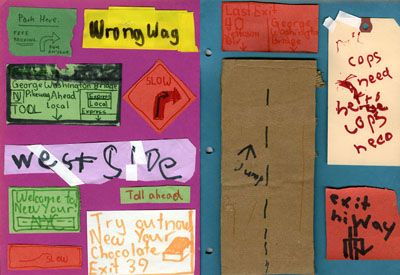how did New Your City start?
with a couple of simple ideas.
well... the story is...
... Sometime in the fall of 2005, Ann Schattle was recruiting her artist friends to organize art and craft projects with children at the Fox Point Library during March of 2006 (Providence Public Library's Youth Arts Month). She talked to Jean Cozzens, who thought, "What could I do that would also be an interesting project for me?" and then said, "Well, I have always wanted to build a city out of cardboard — maybe we could involve kids at the library in constructing a giant metropolis?"
We gathered junk, tape, and boxes from the RI Recycling Center, giant sheets of sticky-backed silver paper and tall tubes from the Holden Recycling Center in Massachussets, art supplies from the library's supply closet, and cardboard from the dumpsters behind furniture stores. Ann brought her digital camera, and we put together construction paper in a loose-leaf binder to serve as a record notebook.
We didn't know what was going to happen, but we taped cardboard down to the carpet, and set up a couple of large structures and towers to inspire future creations.... then brought out boxes of materials and junk, and plugged in the hot glue gun. For the first five minutes, kids were a little bit confused — and then, three afternoons a week for a whole month, we we running around like crazy people, building as many structures, vehicles, trees, roadways, garages, parks, beaches, on-ramps, and airplanes as we could.
Even before the final party happened, people were already asking: are we going to do it again next year? Jean applied to the Rhode Island State Council on the Arts for a grant to support the project — and they gave us a bunch of money, to support many different aspects of the project, and to make it so that the librarians don't have to bring Jean lunch every day like they did last year. Thank you RISCA!
The idea for the record binder came from Jean's work mentoring high school students at New Urban Arts, and partially comes out of their principles for a Sustainable Creative Practice. It is an example of how conscious reflection and documentation can deepen and enrich a simple act of creation.




